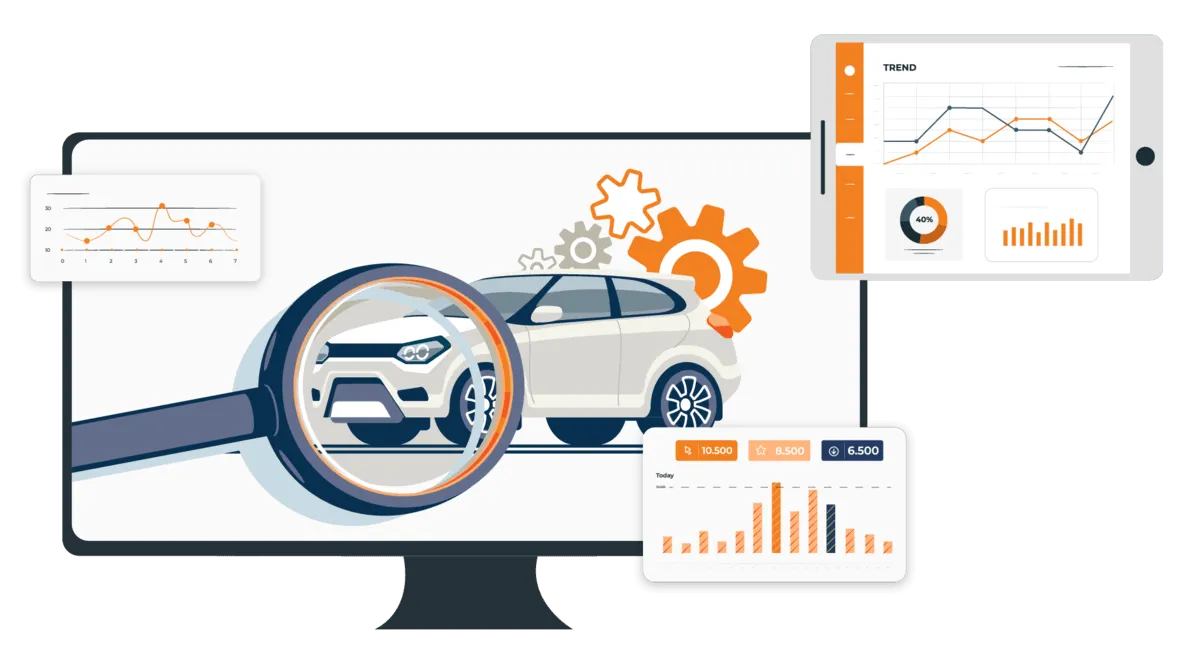As the automotive industry rapidly adopts electronic systems, hybrid and electric vehicles integrate advanced functionalities to improve safety, drivability, and comfort. This results in increasingly complex software and numerous electronic control units (ECUs).
The industry uses the V-Cycle development process to ensure these systems are efficient and bug-free. This process includes requirements definition, software design, testing, and validation, employing methods such as Model-in-Loop, Software-in-Loop, and Hardware-in-Loop testing.
These advanced automotive software testing methodologies allow for safely assessing electric vehicles in hazardous conditions and failure modes, replicating real-world scenarios within controlled environments.
This blog will explore these testing and validation methods, highlighting their role in ensuring the high performance, safety, and reliability of electric vehicles.
The Increasing Role of Software in Automotive Innovation
Software plays an ever-expanding role in the automotive industry, enhancing performance, comfort, and convenience. It controls crucial systems like the engine, transmission, brakes, steering, navigation, entertainment, and security. Moreover, the software facilitates the development of advanced driver assistance systems (ADAS) and autonomous vehicles (AVs), utilizing sensors, cameras, and artificial intelligence to augment or replace human drivers. Additionally, the software enables vehicles to communicate with each other and infrastructure and cloud services, fostering a connected and intelligent mobility ecosystem.
The Significance of Automotive Software Testing in Electric Vehicles
In the automotive landscape, software is the driving force behind vehicles, controlling various functions previously managed by mechanical systems. With modern cars containing up to 150 Electronic Control Units (ECUs), each acting as a small computer dedicated to specific tasks, rigorous software testing is paramount to ensure functionality, usability, and safety.
Traditionally, automotive software testing has been costly, time-consuming, and challenging to repeat. However, advancements such as Hardware-in-the-Loop (HIL) and Software-in-the-Loop (SIL) testing have revolutionized the process.
Software-in-the-Loop (SIL) Testing:
SIL testing allows software code testing and validation in a simulated environment, significantly reducing build time and improving code quality. Benefits of SIL testing include:
- Periodic Testing: Code can be tested as each program segment is completed rather than waiting for the final build.
- Automation: Tests can be automated and run simultaneously.
- Shareable Results: Test results are easily shareable and analyzable.
- Independent Development: Separates software from hardware development, allowing software innovation to outpace hardware.
- Scalability: No need for a dedicated testing bench, making SIL testing easily scalable, repeatable, and faster than manual testing.
Hardware-in-the-Loop (HIL) Testing:
HIL testing validates hardware components by simulating real-world conditions before connecting them to actual ECUs. Although more time-consuming and expensive than SIL testing, HIL testing ensures thorough validation of hardware components. HIL test benches:
- Emulate actual car engine dynamics through real-time mathematical models.
- Use data inputs from devices like cameras and radars.
Both testing methods are crucial for ensuring not just on-road safety but also for addressing:
- Cyber Security
- OEM Trust and Reliability
- Car Brand Health and Image
As automotive innovation continues, software testing remains a pivotal aspect in ensuring the functionality and safety of modern vehicles.
Understanding Functional Testing in Automotive Electronics
Functional testing is a critical process that verifies the proper functioning of automotive electronic components and subsystems according to specifications while ensuring performance and meeting safety requirements. It involves various evaluations to address all aspects of component operations:
- Hardware-in-the-Loop Testing: Real-time simulations create accurate operating environments for testing complex ECUs, systems-on-chip (SOCs), and electronic subsystems.
- Signal Accuracy and Quality Validation: Verify all analog and digital signals operating within specified thresholds without errors.
- Software Regression Testing: Testing software updates and changes to ensure they haven’t broken previously working functionalities in automotive electronic systems.
- In-Vehicle Communications Testing: Checking in-vehicle networking (IVN) systems like automotive Ethernet, controller area networks (CAN), and local interconnect networks (LIN) for reliable data transmissions between electronic components.
- Safety Systems Evaluation: Testing ADAS functions like cruise control, collision detection, automatic braking, and lane-keeping assist under various scenarios to improve road user safety.
- Battery and Power Electronics Testing: Validating the performance, durability, and compliance of power systems, voltage converters, regulators, batteries, battery management systems, and inverters.
- Noise, Vibration, and Harshness Testing: Analyzing how electronic components behave under different environmental conditions and vibration frequencies to ensure they can withstand and not contribute to them.
- ECU-Level Operations: Checking if the circuitry of electronic subsystems works properly when powered up, such as testing the ECU for lighting controls for headlights and signal lights.
- Vehicular-Level Tests: Functional testing of electric vehicle battery packs is crucial for ensuring the EV delivers on range and safety. For example, simulating various power sourcing and sinking scenarios for testing high-voltage battery packs.
- Radar and Lidar Tests: Functional testing of automotive radar and lidar modules using simulated targets crucial for ADAS and autonomous driving.
Functional testing is essential for ensuring automotive electronic systems’ reliability, safety, and performance, addressing various critical aspects across different testing methodologies.
Navigating the Challenges of Software Testing in the Automotive Industry
Automotive software testing is a multifaceted challenge, primarily due to the intricate systems interacting with numerous components and environments. Ensuring high quality and safety standards is paramount, as software defects can lead to malfunctions, failures, or even accidents. The challenges include:
- High Standards: Adherence to stringent quality and safety standards.
- Diversity and Variability: Managing the wide range of software products, user preferences, driving behaviors, and scenarios.
- Complexity and Interdependency: Handling the intricate layers, components, and interfaces of software systems that communicate and coordinate.
- Hardware and Software Interaction: Considering the interactions and dependencies between software and hardware.
- External Factors: Accounting for interactions with external factors such as traffic, weather, and network conditions.
Despite these challenges, software testing is crucial in the automotive industry for various reasons:
- Safety Assurance: Ensuring the safety of vehicles and occupants.
- Compliance with Standards: Meeting regulatory and industry standards.
- Quality Improvement: Enhancing the overall quality of automotive software.
- Reliability Enhancement: Improving the reliability of software systems.
- Cost Reduction: Identifying and fixing issues early reduces costs.
- Performance Optimization: Enhancing the performance of software systems.
- Early Detection of Security Vulnerabilities: Identifying and fixing security vulnerabilities early in development.
- Software Integration: Ensuring seamless integration of software components.
These measures provide assurance and satisfaction to prospective buyers and enhance the overall safety and reliability of vehicles on the road.
The Benefits of Software Testing in the Automotive Industry
Automotive software testing offers numerous advantages for both developers and end-users. Key benefits include:
- Improved Quality and Reliability: Detecting and preventing defects, errors, or bugs enhance the functionality, performance, and security of software products.
- Increased Safety and Compliance: Ensuring the software poses no risks to users, vehicles, or the environment and demonstrating adherence to relevant regulations and standards.
- Cost and Time Reduction: Identifying and fixing issues early in the development lifecycle reduces costs and accelerates development time.
- Resource Optimization: Eliminating unnecessary code, data, or functions to optimize memory, CPU, and bandwidth.
Software testing significantly develops high-quality, reliable, and safe automotive software by addressing these critical aspects.
Best Practices for Software Testing in the Automotive Industry
In automotive software testing, adopting a systematic approach is essential. Key practices include:
- Test-Driven Development (TDD): Ensures quality by writing tests before coding.
- V-Model Testing: Guarantees completeness and consistency.
- Diverse Testing Techniques: Utilizing various methods like unit, integration, system, and acceptance testing ensures comprehensive coverage.
These practices yield multiple benefits:
- Safety and Compliance: Ensures adherence to safety standards and regulations.
- Reliability: Increases software dependability.
- Cost Efficiency: Identifies and resolves issues early, reducing expenses.
- User Experience: Enhances overall satisfaction.
- Innovation and Cybersecurity: Supports innovation while addressing cybersecurity concerns.
- Risk Mitigation: Lowers recall risks and improves customer satisfaction and sales.
Following these practices ensures the development of robust, safe, and reliable automotive software, meeting consumer expectations and regulatory requirements.
Software Testing Tools and Technologies in the Automotive Industry
In the automotive sector, software testing depends on various tools and technologies to simplify and automate the process.
- Software Testing Frameworks: JUnit, TestNG, Selenium, and Cucumber offer guidelines and libraries for designing, developing, and executing test cases efficiently.
- Software Testing Platforms: TestComplete, Katalon Studio, and Ranorex Studio provide integrated environments for managing, executing, and reporting test cases, ensuring comprehensive testing coverage.
- Software Testing Simulators: Simulink, CarMaker, and PreScan offer virtual and realistic representations of software systems and their environments, enabling thorough testing in simulated conditions.
These tools play a crucial role in simplifying, standardizing, streamlining, automating, enhancing, and accelerating the software testing process in the automotive industry.
What’s Next?
The automotive industry is undergoing unprecedented evolution in connectivity, presenting significant opportunities for data monetization across the ecosystem. Key beneficiaries, including OEMs, vehicle fleets, and various data consumers, must act swiftly to capitalize on these opportunities effectively.
HeadSpin’s solutions offer a tailored approach to streamline automobile testing, leveraging the unique advantages of executing tests across any location and testing in-car and app experiences for all users. With a software testing platform like HeadSpin, every vehicle, every driver, and every engagement across the automotive space can be optimized for success.












